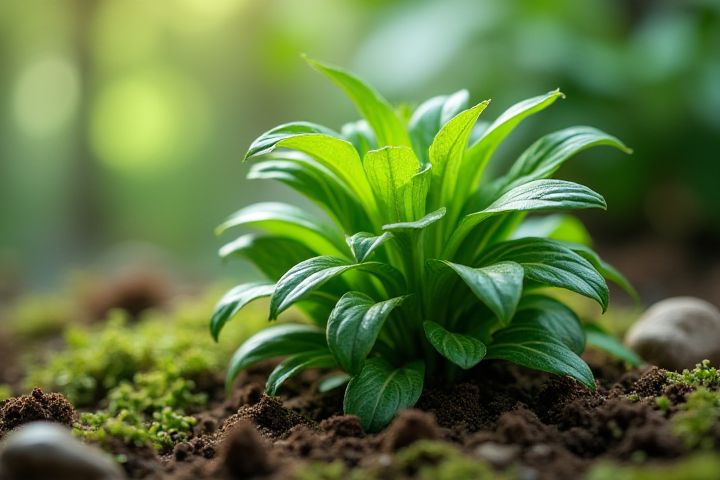
Growing a variety of plants around your house enhances curb appeal and improves air quality. Consider planting fragrant herbs like lavender and rosemary, which attract beneficial pollinators and can be used in your kitchen. Flowering plants such as marigolds and petunias not only brighten up your landscape but also deter unwanted pests. For added greenery, opt for leafy perennials like hostas or ferns that can thrive in shaded areas. You can also incorporate shrubs like boxwoods or hydrangeas for structure and seasonal color throughout the year.
What Plants To Grow Around House
Native plants adaptation
Planting native species in your garden encourages biodiversity and supports local wildlife. Consider incorporating native perennials like Echinacea purpurea (Eastern Purple Coneflower) and Asclepias tuberosa (Butterfly Weed), which attract pollinators and thrive in your local climate. Grasses such as Schizachyrium scoparium (Little Bluestem) provide essential habitat for birds and enhance soil health through their extensive root systems. By selecting indigenous plants, you not only create a sustainable landscape but also reduce water usage and maintenance efforts.
Sunlight exposure patterns
When selecting plants for your home, consider their sunlight exposure needs in relation to your garden's light patterns. For areas receiving full sun, such as southern-facing gardens, vibrant options like lavender, daisies, and coneflowers thrive, attracting pollinators while providing color. In contrast, partial shade areas benefit from hostas, astilbes, and ferns, which flourish under filtered sunlight, adding lush greenery. For heavily shaded spots, consider planting ferns, toad lilies, or astilbe, all of which can create a serene, shaded retreat while enhancing your landscape's aesthetics.
Soil quality and drainage
To enhance your garden's appeal while improving soil quality and drainage, consider planting lavender (Lavandula), which thrives in well-drained soils and attracts pollinators. The native ornamental grasses, such as blue fescue (Festuca glauca), also promote healthy drainage and require minimal maintenance. For vegetable gardens, tomatoes (Solanum lycopersicum) prefer loamy soil enriched with organic matter, providing optimal drainage and nutrients for productive yields. Incorporating perennials like salvia (Salvia spp.) not only stabilizes soil but also enhances its structure, allowing for better water retention and aeration.
Water requirements and availability
When selecting plants for your garden, consider native species that thrive in your local climate, as they typically require less water. For drier areas, succulents like agave or drought-resistant herbs such as lavender are excellent options, as they can tolerate low moisture levels. If your garden has better access to water, you might choose moisture-loving plants like ferns or hostas, which require regular irrigation. Additionally, incorporating rain-gardening techniques can enhance your landscape by utilizing rainwater runoff, promoting sustainable growth and reducing water usage.
Pest and disease resistance
Selecting pest and disease-resistant plants can significantly enhance your garden's health. Consider planting marigolds, known for their natural ability to deter nematodes and other pests. Lavender not only provides a delightful aroma but also attracts beneficial pollinators while repelling harmful insects. For a robust option, try growing sorrel, a perennial herb that is relatively disease-resistant and thrives in various conditions, ensuring your garden flourishes year-round.
Seasonal blooming and color
Consider planting azaleas, which bloom in vibrant shades of pink, white, and purple during spring, creating a stunning display. For summer color, try coneflowers, known for their daisy-like appearance and resilience, with colors ranging from lavender to deep rose. Fall brings the beauty of chrysanthemums, available in a variety of hues like gold, red, and bronze, ensuring your garden remains lively. To extend your seasonal interest, don't forget to incorporate winter-hardy plants like hellebores, which produce delicate flowers and remain evergreen even in colder months.
Maintenance schedule
Choosing low-maintenance plants can enhance your home's curb appeal while saving you time. Consider planting native species such as lavender, which requires minimal watering and offers a delightful fragrance, or succulents that thrive in dry conditions and need watering only every two to three weeks. For vibrant color without extensive upkeep, you might opt for perennials like daylilies, which bloom year after year and demand little care once established. Before planting, ensure your selected species align with your local climate and soil type for optimal growth and durability.
Allergies consideration
If you're concerned about allergies, consider planting low-pollen or hypoallergenic species like Astilbe, which produces vibrant flowers without the wind-borne pollen that triggers allergies. Lavender not only offers a soothing scent but also attracts beneficial pollinators, helping to maintain balanced biodiversity in your garden. Additionally, consider native grasses such as Little Blue Stem; they are typically non-invasive and don't produce significant amounts of pollen. Incorporating these plants can create a beautiful outdoor space while minimizing allergy-related issues.
Space and growth habit
When choosing plants to grow around your house, consider low-maintenance varieties that complement the available space. For smaller areas, like borders or foundation plantings, opt for compact shrubs such as Boxwood (Buxus) that typically grow 2-4 feet high. In larger landscapes, ornamental grasses like Miscanthus or Perennials such as Echinacea can spread 3-5 feet wide, providing ample coverage while remaining visually appealing. For vertical growth, climbing plants like Sweet Peas (Lathyrus odoratus) or climbing roses can flourish well against trellises or walls, offering beautiful blooms and maximizing your garden's vertical space.
Environmental benefits
Growing native plants such as lavender, black-eyed Susan, and coneflower around your house can significantly enhance local biodiversity, attracting beneficial pollinators like bees and butterflies. Incorporating trees like oaks or maples not only provides shade, but also helps in carbon sequestration, absorbing approximately 48 pounds of CO2 annually per tree. Planting shrubs like elderberry or serviceberry can aid in soil erosion control and improve water management by increasing infiltration rates. By selecting these environmentally friendly options, you can create a sustainable landscape that supports wildlife and reduces your ecological footprint.
